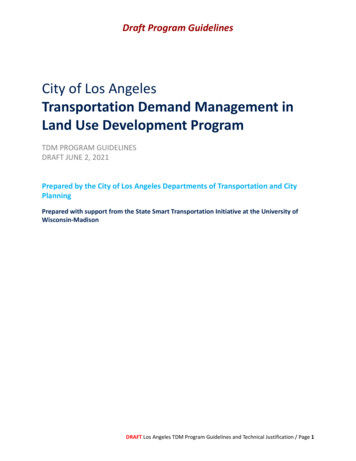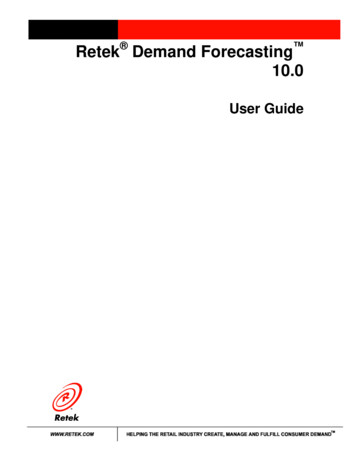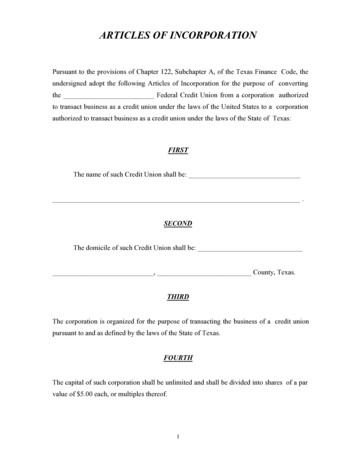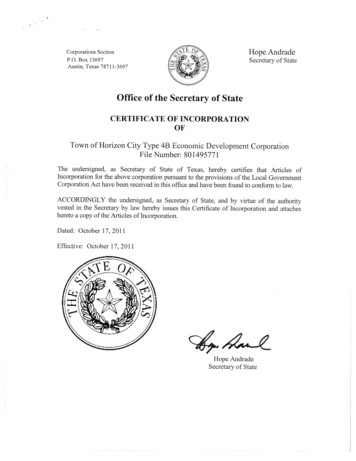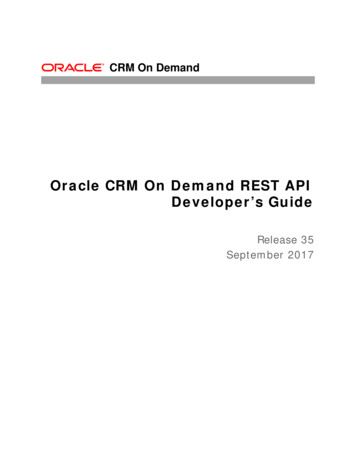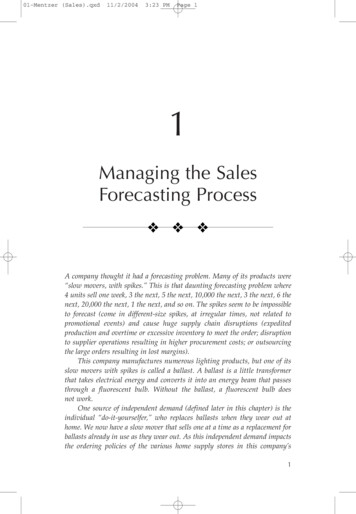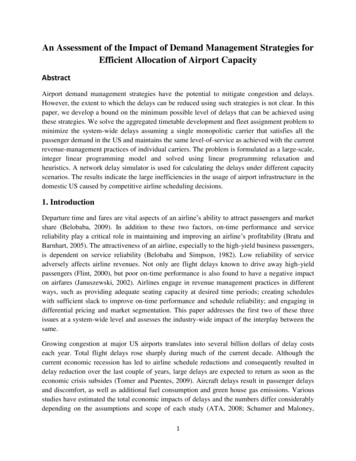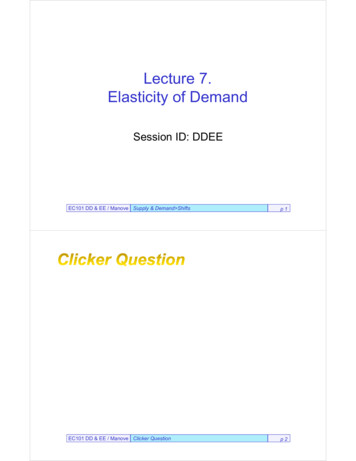
Transcription
Incorporation of Transportation DemandManagement (TDM) into the Development ReviewProcessFinal Report and RecommendationsJuly 2010Submitted to:District Department of TransportationTransportation Policy and Planning AdministrationSubmitted by:Michael Baker Jr., Inc.
Government of the District of ColumbiaDepartment of TransportationIncorporation of Transportation DemandManagement (TDM) into the Development ReviewProcessPrepared By:Michael Baker Jr., Inc.1304 Concourse Drive Suite 200Linthicum, MD 21090Nelson\Nygaard Consulting Associates121 West 27th Street, Suite 705New York, NY 10001Strategic Transportation Initiatives, Inc.1800 Diagonal Road, Suite 600Alexandria, VA 22314Patton Harris Rust & Associates8818 Centre Park Drive, Suite 200Columbia, MD 21045July 2010
Table of Contents1.0 Executive Summary .12.0 Existing Conditions .52.1Introduction to Transportation Demand Management. 52.2The Benefits of TDM . 52.3Washington, D.C.’s TDM Policy . 62.4District Development Application Process. 72.5Federal Government and Military . 83.0 Lessons Learned and Input .93.1Best Practices . 93.2Focus Group Input. 114.0 Recommendations . 124.1 Maximizing TDM with the Current Process (Near Term: Implementation within six months) . 124.2 Long Term Changes to Better Maximize TDM Benefits (Implementation within three years) . 185.0 Other Planning Issues that Indirectly Impact TDM . 23Appendix A:TDM Programs and Ordinances: Literature ReviewAppendix B:Focus Group SummariesAppendix C:Draft TDM Plan RequirementsList of TablesTable 1: Summary of Recommendations . 3Table 1 Continued: Summary of Recommendations . 3Table 2: TDM Recommendations Matrix . 22DDOT Incorporation of TDM in the Development ProcessTDM Programs and Ordinances: Final Report and RecommendationiPage i
1.0 Executive SummaryThe District of Columbia is attracting new residential, commercial, and retail development andredevelopment at an unprecedented pace. This activity, while highly beneficial in many respects,generates significant additional vehicular traffic to, from, and within the District. The currentredevelopment permit process lacks a systematic approach and process within DDOT and among allDistrict agencies for integrating Transportation Demand Management (TDM) policies as a way ofmeeting the District’s goals of reducing auto trips and accommodating travel through the completetransportation network.TDM is now handled on a project-by-project basis, with limited opportunities for coordination amongagencies or implementation of sub-area TDM goals. Current practice applies a one-size-fits-allframework to development, with limited differentiation across diverse geographic areas, developmenttypes, development sizes, or other aspects. This approach does not allow maximization of TDMopportunities or provide a process for consistently applying TDM analyses, nor does it apply TDMexpectations specific to the anticipated traffic impacts of various types and scales of proposeddevelopment.To address these issues, DDOT initiated this analysis of TDM in the development review process. Theproject included three primary tasks:Review of Best Practices and Standards:National best practices were researched to identify examples of effective systematic approaches toTDM. Through the research it became evident that TDM in the development process tended to beaddressed in two general ways:Addressing TDM directly through the development approval process and in particular throughparking ordinances. By limiting parking or encouraging denser development, developers needto consider TDM early on and must participate in ongoing programs to provide alternativeaccess options to ensure the viability of their projects.Developing TDM participation ordinances that require ongoing financial contributions (proffers)from the developer, include enforceable penalties, and generally entail submission of a TDMplan prior to the occupancy of the development.Evaluate the Potential for TDM under the Existing District of Columbia Development Review Process:District stakeholders (including the development community, advocacy groups, District agencies, andagencies from other local municipalities) were interviewed to analyze the existing development reviewprocess and inconsistencies in how the development review process is perceived by different usergroups. Stakeholders were also asked about potential strategies for amending the existing processbased on the needs of their constituents. Staff members from peer municipalities throughout theregion were interviewed for informational purposes, to further assist in identifying successful practicesand highlighting potential pitfalls.DDOT Incorporation of TDM in the Development ProcessTDM Programs and Ordinances: Final Report and RecommendationPage 1
Recommend Improvements and Changes to the Development Review Process:Based on the national best practices and input received from stakeholders, the Project Team developedrecommendations to more fully integrate TDM into the District’s development review process. Therecommendations represent both near-term priorities (implementation within six months) and longterm direction for DDOT’s consideration (implementation within three years). These recommendationsare summarized in Table 1 and are fully described in this report.To assist DDOT and developers in the formulation of TDM plans, a comprehensive listing of TDMmeasures for consideration is provided as an attachment to this document. This table separatesdevelopments into different categories based on the amount of peak hour traffic generated by the siteand whether the application is by-right, a Planned Unit Development (PUD), or one that requires avariance.Any final TDM planning and guidance documentation will require close coordination between DDOT andthe DC Office of Planning (DCOP), the DC Office of Zoning (DCOZ), other departments within the Districtand, possibly, developers themselves to produce a workable procedure that will be acceptable to thePlanning Board and can lead to development of reasonable ordinances in the future. It was evident inthe review of best practices that a legislated solution, unique to the region involved, was necessary for aTDM program to be fully successful. As such it is recommended that a workgroup of districtstakeholders, possibly by DDOT, be formed to investigate the best way to require that TDMconsiderations be included in the development process. Political realities and legal considerations willfigure predominately in this discussion and more parties will need to be involved than were interviewedfor this study. However, to assist DDOT staff in envisioning what a TDM plan might consist of, a draftplan has been provided as an appendix to this document. This generic plan is based on the projectteam’s experience in developing similar plans for other locations in the country and has been modifiedto better reflect the District’s needs. The intent of this document is to spearhead the use andapplication of TDM strategies into the District’s planning process, noting that the final document may bemodified by input from all of the interested parties and stakeholders.Ultimately if TDM impacts are to be quantified it will need to be within a broader context. CurrentlyDDOT does not have a preferred quantitative methodology for assessing the impacts of various planningissues such as project level trip generation, parking policy, land use/development patterns and TDM.Attempting to quantify any single one of these elements in isolation, either for a particular site ordistrict-wide, is not advisable as the interaction between them is a fundamental consideration. Thetransportation impacts of a development can only be quantified if synergetic relations are implicitlyconsidered care is taken not to double count any benefits. Failure to do so will likely result inunderestimation the impact of any one of these element, as is often the case with TDM measures. Anunderstanding of all these factors is vital since ultimately all of them are necessary if the district is tomeet its quality of life, economic and environmental goals. Further investigation and development of acohesive analytic framework that is inclusive of all these elements is warranted.DDOT Incorporation of TDM in the Development ProcessTDM Programs and Ordinances: Final Report and RecommendationPage 2
Table 1: Summary of RecommendationsNear-Term (Implementation within six months)DDOT should make it standard practice that all development plans, regardless ofsize, address all applicable DDOT land use, bicycle, pedestrian, transit, and corridorplans as well as make reasonable allowances for future TDM requirements,particularly sidewalk and bicycle accommodation and transit right of way. Smallscale developments/redevelopments should support all District and neighborhoodplans, but should be exempt from the requirement for a formal TDM package.DDOT should expand its current outreach and advocacy efforts to encouragevoluntary adoption of TDM measures by developers and building managementcompanies in the District.DDOT should develop written guidance explaining the agency’s interpretation of theComprehensive Plan. DDOT may choose to include TDM goals or targets as part ofthis effort.Create a directory of DDOT recognized TDM planners. Require developmentapplications to include a TDM Plan, preferably drafted by a DDOT recognized planneror one with demonstrated credentials. Track TDM plan submissions and baseongoing consultant recognition on submitted TDM plans.As the District’s requirements for TDM measures increase, additional resourceswithin DDOT will need to be allocated to implement and administer the program.All new developments should support the District’s TDM policies as per the District’sComprehensive Plan. The elements do not need to be onerous, particularly forsmaller developments; however, all developments have a role to play in reinforcingthe District’s commitment to transit, alternative transportation programs andservices, and vehicle trip reduction.The formation of Transportation Management Associations (TMAs) within theDistrict is a goal of the Comprehensive Plan. DDOT will need address thisrecommendation and/or develop a functional equivalent to administer and monitorany TDM requirements implemented in the District. (Near-Term (Process), LongTerm (Operational))DDOT should judiciously enforce existing Zoning Regulations to demonstrate theagency’s commitment to furthering TDM measures in the District.DDOT should encourage developers seeking LEED certification to adopt as many ofthe Alternative Transportation related credits as possible.DDOT Incorporation of TDM in the Development ProcessTDM Programs and Ordinances: Final Report and RecommendationPage 3
Table 1 Continued: Summary of RecommendationsLong-Term (Implementation within three years)Until there is an established process for ongoing surveying to demonstrate success,quantification of site-level TDM impacts for the purposes of mitigation is notappropriate.DDOT, DC Office of Planning (DCOP), other relevant district agencies and officialsshould formalize TDM considerations into the current DDOT/OP development reviewprocess.DDOT will need to spearhead an effort to formalize TDM as a regulatory requirementfor new developments and as an ordinance in the Zoning Regulations for the District.This ordinance will need to address not only physical elements at the time of designand construction, but also ongoing survey requirements and the ability to assessfines when violations are identified or program goals are consistently not met.Funding of specific TDM programs will also need to be addressed.Measures of Effectiveness for TDM programs should be two-fold: a reduction in peakperiod vehicle trips and a reduction in overall weekly vehicle trips.Rather than calculating the potential impact of any specific elements of a TDM plan,DDOT should set overall vehicle trip goals and allow the developer to address thespecific goals accordingly, with success determined via ongoing surveys andreporting back to DDOT.DDOT Incorporation of TDM in the Development ProcessTDM Programs and Ordinances: Final Report and RecommendationPage 4
2.0 Existing Conditions2.1 Introduction to Transportation Demand ManagementTransportation Demand Management (TDM) is a set of strategies, programs, services, and physicalelements that influence travel behavior by mode, frequency, time, route, or trip length in order to helpachieve highly efficient and sustainable use of transportation facilities. To effect meaningful travelbehavior change and encourage the widespread utilization of alternatives to Single Occupant Vehicles(SOV), residents and other travelers must first understand the options available in the multimodaltransportation system – how they work, how to use them, and the benefits they offer. This requires alevel of information and support that demystifies travel options and makes them rational and desirablealternatives to the car.TDM policies are the mechanisms for reducing SOV trips by focusing the demand for transportationservices on alternative modes and providing the public with the incentives as well as information to usethese alternatives. This is TDM in the active sense of services and programs. At the same time, tomaintain high-quality transportation services, programs must cater to the needs of all residents,regardless of age, income, or physical ability. Without these characteristics, travel demand will not befully addressed and travelers will be encouraged to use SOV’s or not travel at all. The goal of TDM isessentially to nurture a sustainable community that embraces alternatives to the car while enhancingmobility.2.2 The Benefits of TDM1TDM Benefits for IndividualsTDM services help residents and workers make better use of the many available transportation options.Assistance in finding and using these can be a very valuable lifestyle and economic benefit. For thosewho do not or cannot drive, non-SOV travel options provide the mobility needed to hold employment,go to the doctor, shop, and otherwise lead a fulfilling lifestyle. For others, travel options can relieve thestress, time, or cost of a commute, or allow for more productive use of the time they travel. Themonetary savings in fuel, vehicle wear and tear, or owning fewer vehicles in the household can besubstantial.Moreover, the ancillary health benefits can be extensive; public transportation is many times safer thanthe private automobile and the simple exercises of walking or bicycling, whether to one’s destination orto access public transit, can reduce obesity, lower the risk of heart disease and reduce myriad of otherillnesses. In sum, TDM can be support an improved quality of life on many levels.1A synopsis of select studies substantiating the observed benefits of TDM can be found on the VictoriaTransportation Policy Institute website: http://www.vtpi.org/tdm/tdm58.htmDDOT Incorporation of TDM in the Development ProcessTDM Programs and Ordinances: Final Report and RecommendationPage 5
TDM Benefits for BusinessesBy managing or lessening the number of vehicles accessing and parking at the worksite, TDM can savecompanies substantial capital associated both directly and indirectly with parking costs. They can alsoprovide even more important, though less visible, business advantages by virtue of the benefits toemployees. The benefits to individual employees can also accrue to the company in the form of lessstressed, more satisfied, and productive workers, easier recruitment, an expanded labor pool, expandedservice hours, improved morale, better retention of employees, and less tardiness and absenteeism dueto traffic, stress, or health issues.TDM Benefits for the CommunityThe combined benefits of TDM to individuals and to companies also aggregate to benefit the communityas a whole. Less traffic, improved access, greater mobility, and many choices in travel modes will add upto an enhanced quality of life for District citizens, workers, and visitors. Less vehicular traffic also meansless air pollution, and less contribution to water pollution from urban storm water runoff.TDM Can Be Cost EffectiveOne of TDM’s advantages is that it is more cost-effective and more environmentally sustainable thanproviding additional transportation infrastructure. In one investigation of community-based programsthat promote travel behavior change, the Victoria, Australia Department of Infrastructure found thatsuch programs can be highly-effective in both increasing use of public transit as well as use of otheralternatives to the private car.2 The Victoria study concluded that marketing-based TDM programs haveresulted in financial benefits of 3.09 to 4.70 for every dollar invested in the program. Additionally,businesses may form partnerships with other businesses to share costs for implementing TDM programsand services, such as shuttle services to and from transit stations and shared ride programs, such asvanpooling and fleet management for carpools increasing the return on investment even further.2.3 Washington, D.C.’s TDM PolicyWashington, D.C.’s municipal government provides TDM measures by balancing the transportationsupply with pedestrian, bicycle, and transit facilities in roadway rights-of-way, reducing the cost to ridetransit (Metrochek), and sponsoring alternative modal options (including the DC Circulator andSmartBike DC). The District has also affirmed the prioritization of TDM with specific policies and actionsin its Comprehensive Plan:3Policy T-3.1.1: Transportation Demand Management (TDM) Programs: Provide, support, andpromote programs and strategies aimed at reducing the number of car trips and miles driven(for work and non-work purposes) to increase the efficiency of the transportation system.23Travel Demand Management: Public Transport Business Case, Ker for Department of Infrastructure, Victoria, June2003.Growing an Inclusive City: From Vision to Reality. The Comprehensive Plan for the National Capital: District Elements, AdoptedDecember 2006.DDOT Incorporation of TDM in the Development ProcessTDM Programs and Ordinances: Final Report and RecommendationPage 6
Policy T-3.1.2: Regional TDM Efforts: Continue to pursue TDM strategies at the regional leveland work with regional and federal partners to promote a coordinated, integratedtransportation system.Action T-3.1.A: TDM Strategies: Develop strategies and requirements that reduce rush hourtraffic by promoting flextime, carpooling, transit use; encouraging the formation ofTransportation Management Associations; and undertaking other measures that reducevehicular trips, particularly during peak travel periods. Identify TDM measures and plans asappropriate conditions for large development approval. Transportation Management Plansshould identify quantifiable reductions in vehicle trips and commit to measures to achieve thosereductions. Encourage the federal and District governments to explore the creation of astaggered workday for particular departments and agencies in an effort to reduce congestion.2.4 District Development Application ProcessBeyond sponsoring and funding public TDM initiatives, many municipalities have established TDMprograms as the responsibility of developers, since private developments generate many of the persontrips that the transportation system must accommodate. Private TDM requirements are oftenincorporated into the development application review process, as there is a rational nexus betweenpotential transportation impact and providing TDM measures that mitigate those impacts.The Development Review Division of the Office of Planning (OP) assesses plans that are generally large,complex, and precedent-setting in their potential to change the character of an area. Whiledevelopment is viewed as the economic engine of the District, protecting the integrity of neighborhoodsis equally important. The Development Review Division encourages growth in a way that is sensitive tothe needs and values of neighborhoods. In Washington DC, there are three types of developmentapplications: Matter of Right, Planned Unit Development (PUD), and Special/Variance.Matter of Right applications meet the use and form requirements within the Zoning Regulations, and arenot anticipated to significantly affect the District’s transportation system. Therefore, the District doesnot usually request TDM measures from Matter of Right applications. The exception to this is theZoning Regulations’ requirements to provide bicycle parking, though this is considered a parkingrequirement, not a TDM measure.A PUD is a planning tool which allows a developer greater flexibility in site planning and building design.This flexibility permits the developer to incorporate amenities in the project that exceed those thatcould have been achieved under the general provisions of the Zoning Regulations. When a project isdesignated as a PUD, standards are specifically tailored to the project, including TDM measures.Similarly, when a development application includes a request for a variance, TDM measures arefrequently attached to balance the value of the project and mitigate potential impacts.While the District has not codified TDM requirements as part of the development review process for anydevelopment application category, the policy statements in the Comprehensive Plan have served as theimpetus for creation of a list of voluntary strategies that are recommended in the review process. The“Transportation Demand Management Strategies for Site Plan Review” (Department of Transportation,September 2008), offer 11 TDM elements including bicycle parking and changing facilities, preferentialDDOT Incorporation of TDM in the Development ProcessTDM Programs and Ordinances: Final Report and RecommendationPage 7
parking for car/vanpools and carsharing vehicles, complimentary transit fare media for new tenants, andprovision of information to simplify trip planning by alternative modes. These TDM strategies arerecommended to applicants seeking approval of PUDs or variances, though the District cannot requirethese elements. While many developers have agreed to provide combinations of these strategies, thereis currently no process for long-term monitoring or enforcement; and as such the implementation andgoing maintenance of these strategies in the District is unclear.2.5 Federal Government and Military FacilitiesOne of the challenges facing District planners is that federal facilities and military installations are notnecessarily bound by decisions of the planning council or DDOT. Traditionally both of thesestakeholders have worked closely with DDOT and others to help advance the goals of the local agencies.In terms of TDM, The Federal Government has an aggressive program based on the Federal ExecutiveOrder for Ridesharing, authored by President Jimmy Carter, February 1, 1980. The language in the orderwas based on a program he created for the state of Georgia to address the challenges of the oil embargoin 1979. The order was written into law to increase ridesharing as a means to conserve petroleum,reduce congestion, improve air quality, and provide an economical way for Federal employees tocommute to work. Each Federal agency is responsible for promoting and providing oversight for theirindividual programs with reporting requirements submitted to the Office of Management and Budget(OMB). The following text from the Executive Order lists some of the requirements:Executive Order 12191--Federal Facility Ridesharing ProgramAgencies shall establish an annual ridesharing goal tailored to each facility, andexpressed as a percentage of fulltime personnel working at that facility who useridesharing in the commute between home and work. Agencies that share facilitiesor that are within easy walking distance of one another should coordinate theirefforts to develop and implement ridesharing opportunities.Agencies shall designate, in accordance with OMB, an employee transportationcoordinator. Agencies that share facilities may designate a single transportationcoordinator. The coordinator shall assist employees in forming carpools or vanpools(employee-owned or leased) and facilitate employee participation in ridesharingmatching programs. The coordinator shall publicize within the facility the availabilityof public transportation. The coordinator shall also communicate employee needs fornew or improved transportation service to the appropriate local public transitauthorities or other organizations furnishing multi-passenger modes of travel.Agencies shall report to the Administrator of General Services, hereinafter referredto as the Administrator, the goals established, the means developed to achieve thosegoals, and the progress achieved. These reports shall be in such form and frequencyas the Administrator may require.Like other federal facilities, military installations are largely not legally bound incorporate DDOTrecommendations into site plans. However the military does have a history of working closely with thelocal communities to minimize impacts of their facilities. TDM has taken on renewed importance withDDOT Incorporation of TDM in the Development ProcessTDM Programs and Ordinances: Final Report and RecommendationPage 8
the military (including the NSA) as a result of the 2005 Base Relocation And Closure (BRAC) study andresulting in a migration of employees underway across the greater DC region. TDM has figuredprominently in the plans for growing bases in Virginia and Maryland, and as the military embraces TDM,opportunities will exist for DDOT to endorse and possibly participate in these activities.3.0 Lessons Learned and Input3.1 Best PracticesAs part of the ongoing effort to identify ways of better integrating TDM into the District’s overalldevelopment process, a research effort was undertaken to locate TDM programs across the country andsummarize some of the best practices and approaches. Candidate programs were identified by onlinesources, suggestions by DDOT staff, and practitioners in the field (see Appendix A for the completesummary of best practices). From the initial review, six locations were chosen for more in-depth study:Cambridge, MAMontgomery County, MDArlington, VAAlexandria, VAContra Costa (Bay Area), CASeattle, WA Metropolitan RegionThe research into these programs revealed that including TDM in the development process tends to beaddressed by one of the following three generalized approaches:By directly specifying TDM requirements in the development approval process.Through the use of TDM ordinances that require long-term commitment by developers,property managers, and owners, which influences the development process early on andthroughout the planning stages.A combination of the two options above.Review of the various ordinances, regulations, and planning policies identified during the research effortrevealed a vast array of specific approaches to implementation. Goals varied widely, with someagencies looking at TDM as a traffic mitigation tool, others setting goals for alternative modes oftransportation, and still others using TDM to complement and reinforce their urban planning vision.However, a number of general themes were identified that are relevant to the District’s initiative toincorporate TDM in the development review process:The more successful TDM programs rely on continuing, enforceable ordinances. Stand aloneprograms relying on voluntary measures, while somewhat successful in reducing auto trips,tended to have less influence on the nature or type of the development in a region. This isspecifically applicable to Washington, D.C.’s existing voluntary TDM strategies, which areinconsistently incorporated into development applications and are not verified to ensure theywere implemented as proposed.DDOT Incorporation of TDM in the Development ProcessTDM Programs and Ordinances: Final Report and RecommendationPage 9
While regulation and requirements are included in the most successful TDM programs,education about the benefits of TDM is an integral component to maximizing TDM’s success.Providing developers with research into the value of TDM (as described in Chapter 2), as well asassisting in the marketing of these programs to prospective tenants and owners helps convertthe interest in quality of life improvements into an economic incentive for developers to provideTDM programs.Approach
2.1 Introduction to Transportation Demand Management Transportation Demand Management (TDM) is a set of strategies, programs, services, and physical elements that influence travel behavior by mode, frequency, time, route, or trip length in order to help achieve highly efficient and sustainable use of transportation facilities. .
